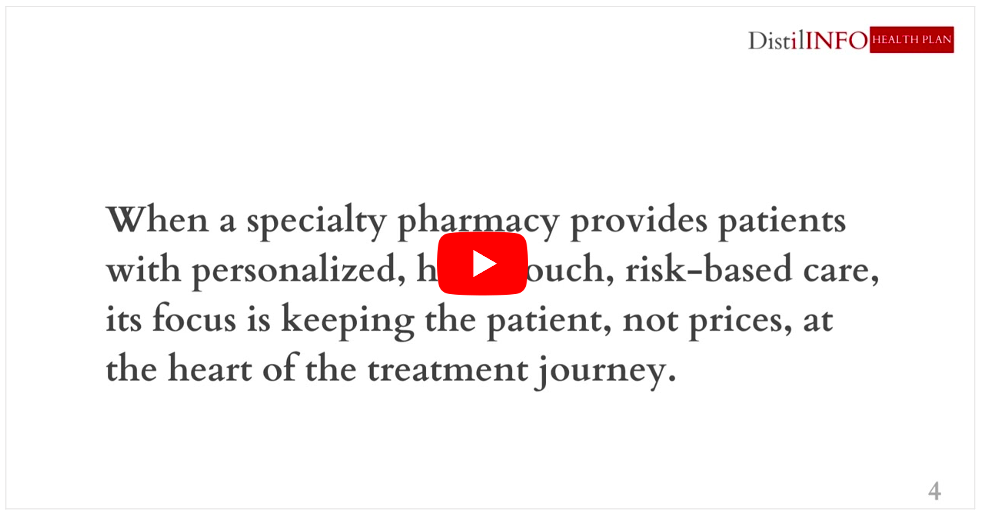
Every year in the US, payers spend $100 billion on medication-related hospitalizations. These incidents come with a time cost, too. Reduced productivity is responsible for a $16,000 loss per patient.
Payers traditionally use cost-cutting measures to rectify this imbalance. However, a comprehensive patient management plan implemented by an experienced specialty pharmacy is another strategy to explore. This approach doesn’t just lower payer costs; it also reduces patient costs, provides collaborative care across healthcare silos, and improves patient outcomes.
When a specialty pharmacy provides patients with personalized, high-touch, risk-based care, its focus is keeping the patient, not prices, at the heart of the treatment journey. Paula Bickley, vice president of market access for Biologics by McKesson specialty pharmacy, notes the powerful result of putting the patient first. “With risk-based care, the intention is really to meet patients where they are and support them through the challenges that we identify through our risk profiling,” she says. “And lower costs is an absolute outcome.”
Keeping the focus on high-quality care helps patients stay adherent to therapy, resulting in lower overall healthcare spending by preventing unnecessary and costly hospital admissions.
Improving outcomes with comprehensive patient management plans
Comprehensive patient management plans, also known as risk-based care plans, establish relationships between patients and specialty pharmacy nurses. At Biologics, when nurses manage each patient’s health, they can address medication side effects or disease-related symptoms early so that patients can remain adherent.
“The ultimate goal for our risk-based care program is understanding those unique challenges and allowing the nurses to work with the patient to create a plan of action to help manage those symptoms so that they don’t progress to a more acute issue,” says Ashleigh Burdette, senior director of clinical innovation for Biologics. “It can affect whether or not they are hospitalized once or multiple times. And that’s where the cost savings really comes into play.”
One-on-one relationships between patients and specialty pharmacy nurses help patients stay engaged and adherent through the treatment journey. This is particularly important for patients at risk of being nonadherent, including people who live alone and those with diagnosis-related side effects that precede therapy. According to Biologics’ internal data, one-third of patients in risk-based care plans are identified as high-risk.
“When we give that patient a dedicated point of contact, they start to learn that when the phone rings, it’s not just the pharmacy calling,” Burdette says. “Instead, it’s their particular nurse calling to check in, so they’re much more likely to engage in conversations. That’s where we’re able to make a meaningful impact and understand what the issues are and what additional education the patient needs. That way, we can tailor the support to their individual circumstances.”
Comprehensive patient management plans can reduce the need for urgent medical care
Nurses are often the first healthcare providers to discover medication side effects since they typically communicate with patients more frequently than doctors do.
As a result, nurses’ early efforts may help patients remain adherent. Biologics’ Internal data shows that patients with risk-based care plans are four times less likely to experience disease progression. They also have lower hospitalization rates, which keep payer costs down.
When a 75-year-old ovarian cancer patient went to the hospital for shortness of breath, her care team was the first to hear about it. They promptly created a care plan, educated the patient, and informed her provider’s office. Next, the care team worked closely with the hospital oncologist and discharge planner to get the patient well enough for a speedy discharge. By reducing the patient’s hospital stay by four days, the Biologics team’s enhanced risk-based care plan saved an estimated $16,000 in healthcare costs, plus the cost of any further complications.
“The system is not really designed to identify avoided medical spend, but it is critically important,” Bickley says. “If you’re not looking for, or cognizant of, this longitudinal care from diagnosis to clinical endpoint, you may be missing the fact this patient had fewer hospital days and fewer urgent care visits.”
Comprehensive patient management plans keep medications on track
When it’s time to refill a patient’s prescription, a Biologics pharmacy technician calls the patient to determine how much medication they have on hand. This is because it’s common for cancer patients to have excess inventory because of either skipped doses or prescription changes.
Two days after a 74-year-old patient with gastrointestinal cancer received her medication, her doctor halved her dosage, which meant that her one-month supply was suddenly a two-month supply. When it was time for a refill, a pharmacy technician called the patient and heard about the medication change. So, instead of sending the usual dosage after one month, the Biologics pharmacy sent half as much medication after two months, ensuring that the patient used all the pills. This saved the payer $23,000, the cost of a two-month medication supply.
“That resetting of the refill date is completely hidden; it’s not something that jumps off the page as saving people money,” Bickley says. “But there are still patients that get autofills of their oral-targeted therapy — not from Biologics; from other pharmacies — that they may never use. That’s a whole other level of cost [for payers].”
And it’s precisely these patient management plan details that an experienced specialty pharmacy is poised to catch and rectify, leading to lower costs and better outcomes.
Source: Healthpayer Intelligence

